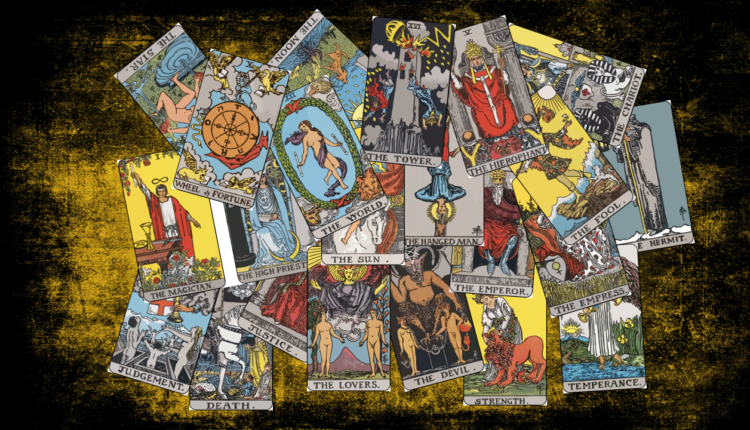The Structure of 22 Major Arcana Cards
Menu of Contents
The 22 Major Arcana
Major Arcana play an important role in a Tarot deck. Generally, they are cards that any new Tarot users choose to learn first because they are less (there are 22 Major cards compared to 56 Minor cards) and partly, they are considered deeper, more meaningful, and have more “spiritual” parts of life. Those cards sign for things, for events and human beings, which is generally meant to be “heavier” and need to be considered carefully more than what it represents.
Major Arcana cards are the twenty-two types of event agents that affect real life and the human spirit. These can be events which are out of human control such as old age, death, illness, or the physiological and psychological maturity of every individual in life.
Facing events that are uncontrollable, the treasure in the hidden hermeneutics gives us acceptance, not escape, into the illusion. It is insight, to face permanent suffering in life. Major Arcana cards come from inner and outer practicing, which help us break the chains of suffering and to be free.
The 4 groups of Major Arcana cards
Major Arcana cards are usually grouped as follows:
Group 1: The personality in 22 Major Arcana cards
The Fool: innocence, beginnings, spontaneity, a free spirit.
The Magician: manifestation, resourcefulness, power, inspired action.
The High Priestess: intuition, sacred knowledge, the divine feminine, the subconscious mind, etc
The Empress: femininity, beauty, nature, nurturing, abundance.
The Emperor: authority, establishment, structure, a father figure, ego, power.
The Hierophant: spiritual wisdom, religious beliefs, conformity, tradition, institutions.
The Lovers: love, harmony, relationships, values alignment, choices. passion.
The Hermit: soul-searching, introspection, being alone, inner guidance.
The Hanged Man: sacrifice, pause, surrender, letting go, new perspectives.
Group 2: Objects in 22 Major Arcana cards
The Chariot: willpower, success, action, determination, struggling with external difficulties.
Wheel Of Fortune: good luck, karma, life cycles, destiny, a turning point.
The Tower: sudden change, upheaval, chaos, revelation, awakening.
The World: completion, integration, accomplishment, travel, freedom, intellectual, not dominated by external forces.
Group 3: Astronomy in 22 Major Arcana cards
The Star: ego, hope, faith, purpose, renewal, spirituality, friendship, wish.
The Moon: instinct, illusion, fear, anxiety, subconscious, intuition, deep emotion, madness.
The Sun: superego, positivity, fun, warmth, vitality, trust, achievement. The three astronomical elements represent not only the celestial body but also the internal mental elements of human beings. It may be the Moon which performs for the original instinct, symbolizing It; the Star which describes the individuality of Ego; and the Sun expressing the transcendent, beautiful things that people always want to be, symbolizing by Superego.
It, Ego and Superego according to Sigmund Freud are the three pillars of structure that make up the domain of consciousness. Especially with the Tarot De Vieville, these three cards represent three groups of magic to help people reach a higher level in life.
The Star card is the method of mental transformation, strengthen the intellect through the arithmetic and astrology. The Moon is the method of physical transformation through magic. The Sun is the method of soul conversion through the delivery of spirits, summons or method of researching about life and death.
Group 4: Specific features/events in 22 Major Arcana cards
Death: endings, change, transformation, transition, events that have a great impact on the spiritual life.
Strength: courage, persuasion, influence, compassion, energy.
Justice: fairness, truth, the cause and effect, rules, diversion, punishment.
Judgment: awakening, rebirth, inner calling, absolution, responsibility.
Temperance: balance, patience, purpose, moderation, mental balance.
The Devil: desire, instincts, temptations, occupations, needs, attachment, addiction, restriction, sexuality.
The different groups of Major Arcana cards are systematically and structurally distinct. This recognition will have a definite effect on the meaning of the cards.
While reading, the Tarot readers should focus exclusively on the Major cards and their related abilities with each other as well as with the other cards in the deck. It brings special focus and color the rest of the story that the card reveal to you. For example, when a positive major card placing next to two or three minor cards with negative meaning, it quite dissolves or negates the “negative” part of the story which the minor cards show.
<<< Related Article >>> The Great Journey Of 22 Major Arcana Cards
Easily understanding the structure of 22 Major Arcana cards through “The Journey of the Fool”
In order to be able to memorize 22 Major Arcana cards and understand each card name, we can read ” The Journey of the Fool” below.
The Journey of the Fool
The journey of the Fool is a metaphor for the life of each individual. Each of the cards in the Major Arcana represents a journey – an experience that each person must combine to aware one’s self. The following description is based on the keywords for each Major card.
(0) The Fool card
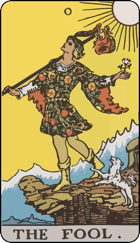
Starting with the Fool (0), the card of the beginning. The Fool represents each of us at the beginning of our journey. He is very naive since only the pure soul has a naive belief in starting to enter life without paying attention to how much danger and suffering in front.
At the beginning of the journey, the Fool is like a child, always open and spontaneous. The picture on card 0 shows him stretching his arms and heading up. He is ready to take on and experience any challenge he encounters on the way, but at the same time, he does not notice the cliff in front of him which he is about to pass. The Fool is unaware of the challenges he will face as he is currently immersed in the desire to reach out to the outside world.
The Fool represents something outside of the Major Arcana. Number 0 is an unusual number as it is exactly in the middle of the system of numbers – the balance between positive and negative. At first, the Fool was placed in the middle of things. He is empty (like a zero), but always want to get out and learn. This determination seems foolish, but is that all?
(2) The Magician and (3) The High Priestess
As soon as starting the journey, the Fool immediately encounters the Magician and the High Priestess, the great forces that create a world of awareness. These are the characteristic characters of the physical universe that once we can shape some aspects of the experience, we automatically evoke the contrast between them.
In 22 Major Arcana cards, the Magician represents Yang (the concept of Yin and Yang in Chinese philosophy). He represents the source of active and masculine creativity. This character also represents conscious perceptions in each of us. The Magician allows us to influence the world around us by focusing on our strengths and our individual volition.
On the contrary, the High Priestess represents Yin. She represents mysterious unconsciousness. She creates an abundant background to make creative events. The High Priestess character represents our unrevealed potential which will reveal when there is the appearance of some positive disciplines.
Both of two words “Yin” and “Yang” do not mean good or bad. This is just the distinction of human personality which is not applicable to Tarot. The Magician and the High Priestess in the Major Arcana are two characters that are perfectly balanced in value and importance.
Each side plays the necessary role to maintain equilibrium. We can consider the “Yin” like a shadow, but without the shadow, we can not see the light, and if there is no “Yang”, we can not create the light.
(4) The Empress
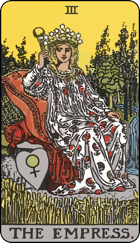
As he grows up, the Fool is more aware of the surroundings. Like all other children, the first person he recognizes is the Mother, a warm woman, full of love who nourishes and cares for him. He is well aware of Mother Earth, who nurtures him in a greater meaning.
In the 22 Major Arcana cards, the Empress (3) represents the natural and sensual world. A child is always eager to discover everything that he feels, smells and tastes. The Fool does not look and hear enough to satisfy all his senses. Therefore, naturally, he will always feel joyful in the arms of the infinite love of Mother Earth, who always embraces us.
(5) The Emperor
The next person the Fool encounters is the father hidden in the character of the Emperor (4). He is the representative character of structure and power in 22 Major Arcana cards. When a child leaves his mother arms, he will be aware that the world in which he lives has many colorful parts.
The child then reacts to life in predictable ways that allow him to discover and experience new joys from the discovery of the structure of the world.
The Fool will also have access to social disciplines. He will know that the intent of a human being is not always the most important condition, but in fact, he also needs to show some other necessary actions to be able to find happiness. There are powerful people who will develop the rules of behavior, create barriers that can cause him to be discouraged. However, thanks to his father’s patience and perseverance, the Fool will gradually begin to understand the purpose of these actions.
(6) The Hierophant
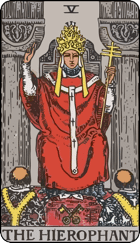
After all, the Fool steps out of his home and embarked on a wider world. He exposes to systems of belief and cultural traditions and begins to learn rituals. The Hierophant (5) represents the organized belief system that begins to form in a growing child.
The Hierophant is the interpreter of complex knowledge and secrets in the Major Arcana.
In the fifth card, the religious figure blesses two monks. Perhaps, he is ritually admitting them as church members. Although this image has many religious details, what the Hierophant represents is really the image that symbolizes the beginning of all things.
A child is taught the realities of society and becomes part of a particular culture and worldview. He learns to recognize himself in a group/community and discover his sense of belonging. He loves to learn and search about the customs of society and shows his level of adaptability to those customs.
(7) The Lovers
Now, the Fool will face two new challenges. Firstly, he will experience a feeling of desire for sexual harmony with another person. Before this point, he always considered himself as a center in the Major Arcana. From now on, what he wants is a balance, like the one described in the Lovers (6), in order to approach and become a half part of a relationship. Shortly, he desires for a relationship.
The Fool also needs to make decisions based on his own belief system. It is enough to follow existing perspectives for the stage of learning and maturity, at some point, he will have to determine his true value if he is honest with himself. He must begin to doubt the opinions he has heard and learned from others.
(8) The Chariot
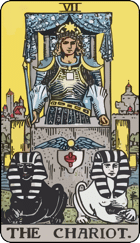
When the Fool comes to adulthood, he has his own distinct identity and ability to control himself. Through discipline and willpower, he now knows inner control, which helps him conquer all situations.
The Chariot (7) in the Major Arcana represents the most powerful oneself up to this time of the Fool. In card number 7, we see a proud and majestic figure riding a glorious chariot through his life. He holds in hands the controllability of himself and all the thing he observes. Right now, the Fool’s success is all he has been wished for, therefore, he feels satisfied. The Fool is now filled with the confidence of youth.
(9) Strength
Over time, life brings new challenges to the Fool, including the harsh trials of suffering and destruction. He has many chances to recognize the value of strength – Strength (8) in the Major Arcana. He is motivated to develop courage and to find solutions to be confident even if there are failures.
The Fool also explores the value of patience and tolerance. He realizes that the Chariot’s draconian command style should be soothed by goodness and soft power. Along with that is the emergence of intense desire when The Fool thinks he is able to control everything well, including himself.
(10) The Hermit
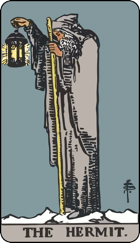
Sooner or later, there will be a time for the Fool to ask questions “why?” for himself. He would be eager to find answers to unnatural questions go beyond thoughts, such as the reason people live and survive, why live then we are all distressed and die? Thus, we have the Hermit (9) represents the need to find deeper truths in the Major Arcana.
The Fool starts to pay attention to the inner aspect of himself, trying to understand his feelings and motivations. The existing world is no longer attractive to him anymore, now he is looking for moments of loneliness, away from the noisy activities outside the society. During that time, he can find a mentor or a guide who will be able to offer advice and directions that are suitable for him.
(11) Wheel of Fortune
After a time of searching for the soul, the Fool begins to notice how everything is linked. He starts to have a wide perspective on the wonders, models and complex cycles of the world out there. The Wheel of Fortune in the Major Arcana (10) is a symbol of a magical world in which every good person operates in harmony. When the Fool glimpses the beauty and the order of the world, he will quickly find the answer to the problems he questions.
His experiences seem to be the result of fate. The chain of change will begin when a knock or a miracle happens. The Fool may have realized his fate through a series of events that led him to this turning point. When he becomes alone, he feels ready for movements and activities. His point of view is wide, and he sees himself in a critical step of a great plan. His sense of purpose is being restored.
(12) Justice

The Fool now must consider whether these views mattered to him personally. He will look back on his life to trace the cause and effect relationships that have contributed bringing him to the present situation. He has to take the full responsibilities for his past actions as well as be able to overcome mistakes and ensure a better future. Justice must be present to help him erase his mistakes.
This is the time when the Fool needs to make a decision. He will have to make very important choices. Will he make the right decisions and fit his insights or will he slip into the lack of emphasis and awareness which is slowing down his future growth?
(13) The Hanged Man
The Fool courageously moves forward. He realizes his point, but he also find out life is not easy to control. Sooner or later, he will face himself, which is a very harsh experience. This heavy challenge will cause him to collapse until he has no choice but to give up and let go.
At first, the Fool feels like a failure and lost. He thinks he loses everything; but in depth, he also learns great truths. He suddenly realizes that when he lets go of the challenge and no longer want to control himself again, everything will be back to a stable operating state.
When the Fool becomes more open and weak, it is when he discovers miraculous support from himself. He learns to cede what he experienced instead of fighting with them. At that moment, he unexpectedly feels joy and begins to get on well with life.
The Fool feels like floating in endless moments without pressure. In fact, his world was turned upside down. The Fool becomes the Hanged Man (12) in the Major Arcana, despite being clearly tortured, his inner self is very calm and peaceful.
(14) Death

The Fool now begins to get rid of the old habits and the things that cause him exhaustion during his journey through 22 Major Arcana cards. He removes unnecessary things because he values the basic elements of life. He overcomes the endings as he leaves behind the deep aspects of life.
The way he resolved as if it coming to an end whereas it is the death of his previously familiar way of thinking so that he would be able to develop himself a new life. At the time, such determined changes seem to devour the Fool, but eventually, he goes beyond realizing that the death would not be an eternal state. It is simply a transition from an old life to a new life which is more meaningful.
(15) Temperance
Since experiencing himself as the Hermit in Major Arcana, the Fool has consistently fallen into a sense of chaos, the dilemma of emotions. Now, he has found a steady state of equilibrium – Temperance (14). He discovered the true equilibrium. Having undergoing harsh events helped the Fool appreciate moderation.
The Fool combines all aspects of himself into a whole body of concentrated health and happiness. Let’s take a look at how the graceful the angel in the card (14) looks when compared to the keeper of the rules to see who is strong but rigid in the card the Chariot (7) before? The Fool has come a long way to realize that this life is always inherently harmonious.
(16) The Devil
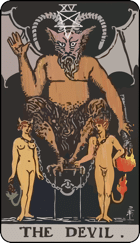
The Fool has health, peace of mind and a calm attitude. What more does he need? The Fool is still brave and he continues to pursue exploring the deepest aspects of himself in daily life. Soon he will face the Devil (15) in the Major Arcana.
The Devil is not a character representing a bad thing or evil lurking us out there. The Devil, more precisely, is the knot of ignorance and despair in many forms and levels inside each of us. The temptation of substance blinds us so much that we often do not realize we are dependent on them.
We live this life within a limited range of experiences without recognizing that this wonderful world is our true heritage. The pair on the card 15 is tied together, but they accept that. Although they can easily free themselves, they do not even care about the current situation. They are partly like the Lovers but they are unaware that their love is limited to a narrow range. This ignorance or foolishness will create desperation deep in mind.
(17) The Tower
How did the Fool escape from the Devil? Will he also have a chance to escape the influence from the Devil? The Fool can only escape by unexpected elements happening in the Tower (16) in the Major Arcana. The Tower is the fortress of the self that each of us has built a fence around our beautiful souls. This fort is gray, cold and hard. It seems like construction to protect, but in fact, this fort looks like a prison.
Sometimes, a huge crisis event will be able to generate enough energy to break the walls of the Tower. On card number 16, we see a lightning strike on the fort. This lightning bolts the people in the building, scaring them to death and falling to the ground. The crown at the top of the building reminds us that they used to be the proudly powerful leaders, before being demoted by a mightier force.
The Fool would probably need a serious reform if he wanted to free himself, but the painful experiences that he had to bear were worthy of consideration as a result. In particular, the dark desperation disappears immediately, giving way to the shining light of truth.
(18) The Star
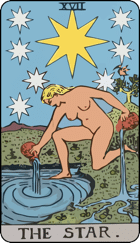
In this card, we can see that the Fool is now able to stabilize the state of calm. The beautiful images on the Star (17) have proved this. The naked woman in card number 17 whose soul is no longer hidden by any form of disguising. The dazzling star shines in the clear sky, like a lighthouse rising on a lamp full of hope and inspiration.
The Fool is full of faith, completely covering the negative energy sources that the Devil brought before. He has confidence in himself and his future will be restored. His heart was full of joy and he longed to spreadly share this belief with the rest of the world. His heart is wide open and his love is expressed freely. Peace after the storm is a magical moment for the Fool.
(19) The Moon
What influence can break this perfect quiescence? Is that another challenge for The Fool? The fact is that it was his joy that made him easily vulnerable to the illusions of The Moon (18). The joy of the Fool is a state of feeling. His positive emotions are not related to a clear vision of the mind. In his dreamy state, The Fool will be very easy to trip the illusions, distorted perceptions and misleading images that affect him.
The Moon in the Major Arcana is the object of creative imagination. The Moon guides the way for strange and beautiful thoughts which are raised from the unconscious, but the fears that are deep inside will also appear at the same time. This experience can make The Fool feel lost and bewildered.
(20) The Sun
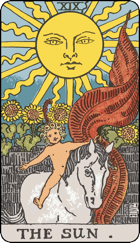
Transparency and brightness of the Sun (19) in the Major Arcana led the imagination of the Fool. The Sun shines on all the darkest places. That light dispels the clouds of confusion and fear. The Sun’s light helps to enlighten everything so that the Fool can feel the enlightenment of the good of the world.
Now, he is enjoying a lot of energy and enthusiasm. The Star’s opening element is now condensed into a belief. The Fool becomes a naked kid in the 19 cards joyfully riding on horseback and eagerly welcomes a new day. There are no harsh challenges, and the Fool is feeling full of energy. He finds himself in a great amount of knowledge while finding the things he needed. He may also aware of his greatness.
(21) Judgment
The Fool is now reborn. All the failure and mistake have been stripped away, leaving a bright new himself. He discovered that there is not the fear but joy is truly central to life.
The Fool feels like being forgiven. He forgives himself and others as he knows that his nature is really pure and good. He may have regretted his previous mistakes, but he also knows that these mistakes were due to the stupidity of not realizing his true nature before. Now, the Fool realizes how to clean the past as well as become a new person, ready to start new things.
This is when the Fool needs to make a deeper Judgment (20) about his life journey through 22 Major Arcana cards. His meditation day has come. Now as he truly realizes his nature, he can make the necessary decisions for the future. The Fool can choose wisely what to cherish and what to eliminate.
The angel on the card 20 symbolizes the call for the Fool to stand up and fulfill his promise from the “superior self”. At this time, the Fool will discover the real motive as well as the reason for him to come to this life. Suspicions and hesitations gradually fade away which means the Fool is ready to pursue his dream.
(22) The World
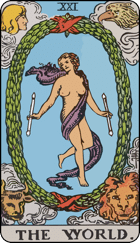
The Fool is back into the World (21), but this time with a position of a person who understands. He has made all the different points in himself to achieve the whole thing. He has reached a new level of happiness and fulfillment.
After all, the Fool will also experience a full and meaningful life. His future has become extremely promising. The Fool will now actively participate in the new world. He shaped it by sharing what he had as well as showing his unique talents, and then realized he succeeded and grew wherever he went. The Fool has acted on things in the way he felt very certain, therefore, the whole world would witness his effort to be rewarded. His achievements are huge.
And so, the journey of the Fool through 22 Major Arcana cards is not a foolish trip at all. Through his patience and honesty, the Fool was able to rebuild the natural courage that first motivated him to seek himself, but now he was fully aware of the location of himself in the world. This cycle has ended, but the Fool will never stop growing up. Soon enough, he would be ready to set out for a new journey, leading him to greater levels of insight.
The structure of the 22 Major Arcana cards is described as a journey of the Fool, both in a coherent and logical way. After experiencing many challenges, self-questioning, deadlock, and enlightenment, the Fool has finally returned to himself in a wider aspect. This helps the experienced readers, as well as the beginners who learn about Tarot, have an overview and basic knowledge of the 22 Major cards, from there, the reading activities will become easier and more smoothly.

